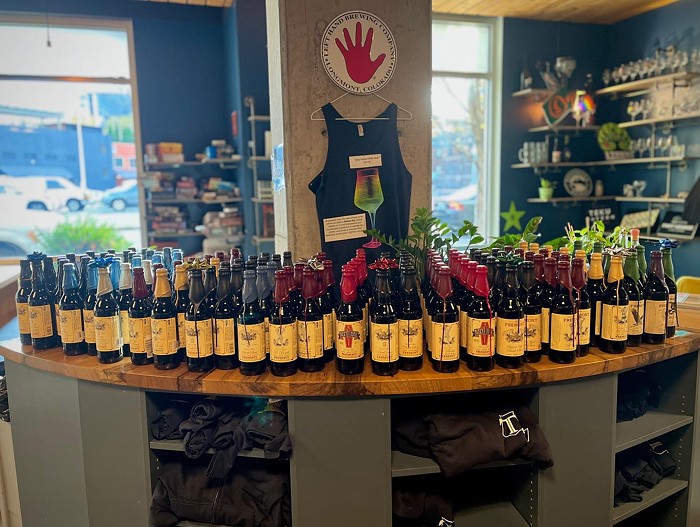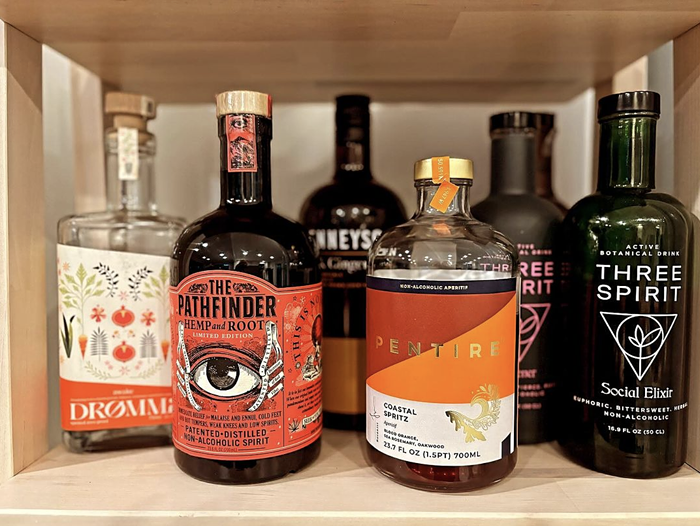The new Coterie Room is an official Big Deal, and it looks marvelous. The former Restaurant Zoë space, on Second Avenue kitty-corner from the Crocodile, got exactly the right updating: nothing dramatic except one very impressive crystal chandelier and, antithetically, one wall with a lush, vertical square of living plants. The layout is the same, with the open kitchen in one corner and the bar in another. It's already hard to remember—you know how once a place changes, especially when it changes correctly, you can barely picture how it was before?—but Zoë, I think, had UFO-by-way-of-the-'90s light fixtures. Those are gone, replaced with elegant tin-ceiling-type relief panels, white on white. (Zoë is set to reopen in January at 14th and Union.) A white-upholstered banquette is elegant, too; you're now in a different, better world in which red wine would never spill. Dark tables and the dark wood floor provide a sense of gravity. A large mirror on one wall has a message written across the bottom, faded out to almost subliminal: "We love you. We serve you good food."
The "we" is Brian McCracken and Dana Tough, the chef team behind Spur (which is just around the corner) and Tavern Law (up on Capitol Hill), which have been on you-have-to-go-there lists in Food & Wine and GQ. The other two places feel more like craft cocktail bars with food—one a contemporized Old West saloon, the other slick speakeasy-style—while the Coterie Room is most definitely a restaurant, one with "class," as the gentlemen themselves have said.
The menu, to be frank, looks a little boring at first. This is apparently intentional; in press materials, McCracken and Tough promised "approachable and delicious, good American classics." Classics include foie gras torchons, duck confit, pan-seared trout, and a grilled rib eye; in the approachable department, there's mac 'n' cheese, poutine, a Painted Hills burger, roasted pork shoulder. (You can also order a six-pack of beer for the kitchen crew for $10 to "show them your appreciation.") The prices skew less approachable, more crystal-chandelier, with entrees weighted toward the higher end of $20 to $35. (While there's lots of decanter-worthy wine, it goes as low-budget, surprisingly, as $7 a glass.)
Two salads—beets with pistachios and Cowgirl Creamery cottage cheese ($8), and endive with candied walnuts and aged gouda ($8)—were merely very good versions of precisely what they sounded like. No issues (except, to indulge in some nitpicking, the small and high-sided bowls—more cereal than elegant), but nothing special. Same with sea scallops ($26): brown-butter-seared, served with a swipe of creamy cauliflower puree, a few cauliflower florets, and sultanas and fried capers for contrast—very good and very unexciting, even for a scallop fanatic.
Now, the smoked king crab—that is something else. It's $29, and it's a heap of preternaturally tender, moist crab meat—whole joints from the legs—with just the faintest smokiness, as if from a distant driftwood beach fire. The crab is atop a cake of hash browns that is almost too buttery, if such a thing were possible; the hollandaise has the lemon dialed down and the barest hint of bacon, just enough to make you think how good this would be for breakfast. (It's on the weekend brunch menu, in a slightly smaller portion, for $18.)
But here is what you should order at the Coterie Room: the cracklins, the carrots, and the chicken, which is fried. Bring one friend if you want leftovers, two if you don't. (You want leftovers.)
To call the cracklins ($6) that is a bit of a misnomer, if you want to get into semantics (go ahead—I'll be over here eating the cracklins). They look more like plain old pork rinds, and they're not pig at all. They're puffs of tapioca flour—like the crumpled-shell-shaped shrimp chips you might get at a sake bar, but tasting way less like oceanic packing peanuts, and way more like completely delicious. The tapioca flour is hydrated with ham-hock stock, then meets the alchemy of boiling oil, with supremely porky but also extremely light results. The cracklins seem to float up out of their dish and into your mouth; due to the uncanny lightness, you can eat many, many more of them than you feel like you should. Absurdly, they come with a small ramekin of very rich, very thick béchamel sauce studded with bits of black truffle and, if I'm not mistaken, laced with cheese. Dipping the cracklins into the fondue, the lightness against the lavish, feels sort of wrong; instead, I ate most of the fondue straight, swiping the end of it up with a finger. You could absolutely just go sit at the bar at the Coterie Room, gaze at the wall of plants, eat the cracklins, and leave, secure in the knowledge that your life is more complete.
The carrots ($9) function in this meal as a psychological necessity—you are having cracklins and fried chicken, so you better have carrots. But lord, these are fine carrots—heirloom baby ones, itty-bitty enough that some still have a little bit of stem attached, which is just as sweet and tender as the rest. To counter the sweetness, there's briny, earthy taggiasca olive, which is billed as a vinaigrette but is so generously all over the carrots that it's more like a tapenade. For color and freshness: flat-leaf parsley. And in case your cholesterol level is descending, the carrots, still so firm, are cooked in lots of coriander butter. If you think you don't like cooked carrots, you are wrong.
Then there's the fried chicken. It's $32 for a "family-style" platter—four pieces of chicken, along with the world's creamiest mashed potatoes studded with still-crispy pieces of pork fat, a small pitcher of gravy, and a too-small amount of frisée salad (but that's what you got the carrots for). If you think there's something magic about this fried chicken, you are correct: It's the magic of science. The chicken is brined for a day to increase its moisture content—it's just a salt-water brine, they say, although somehow the flesh ends up tasting almost sweet—and then it's cooked sous vide at 148 degrees for five hours, sealing in all that moisture. The buttermilk coating has a base of both regular flour and Trisol—a neutral-tasting, soluble wheat fiber ordered from Ferran Adrià, of El Bulli fame, which makes fried things more crunchy, less oily. It really, really works.
A variation on this fried chicken, made with honey, is legendary at Tavern Law, and on a Saturday night, you'll already see platters being carried to tables all around the Coterie Room. Yes, it's expensive, and no, it doesn't match the swanky surroundings, but damn, it is good. (Note that trying to eat the leftovers while typing is not recommended.)
The service at the Coterie Room suits it perfectly—you'll receive a warm rosemary roll that's been nestled within a napkin on a silver tray, then another if you finish that one. They'll leave you formally alone or conspiratorially help you choose a dessert, as you wish (get the Valrhona chocolate tart). When the place gets full, it can take a few extra minutes to receive attention, but the beauty of the room and the buzz of the place make you not mind. The word "coterie," in case you've forgotten, means "an intimate and often exclusive group of persons with a unifying common interest or purpose." And the Coterie Room feels like a private club, united by a common interest in good food, especially modernist fried chicken. ![]()
This article has been updated since its original publication.



















